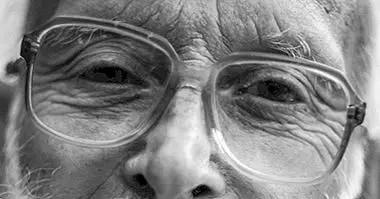Cloistered syndrome: types, causes and treatment
Imagine living trapped in a totally soundproofed prison, from which you get all the information from outside but without your voice or your actions can be seen through the walls. You can not do anything or talk to anyone, or have an interaction with the environment. The world knows you exist, but apart from that you can not practically know how you are, how you feel, or what you think.
Now imagine that prison is not other than your own body. This is what happens to people who they suffer the denominated syndrome of enclosure , a medical condition so disturbing that there is already at least one movie whose plot revolves around it: The Diving Bell and the Butterfly.
- Maybe you're interested: "The 15 most frequent neurological disorders"
The confinement syndrome
A neurological syndrome in which the subject is unable to perform any motor activity despite maintaining consciousness is called a cloistered syndrome. The person is able to perceive the environment normally and is aware, but can not participate or give an answer to the stimulation. As usual, the only exception to this fact is the eye movement and possibly the upper eyelid , which remain preserved.
The people who suffer from this syndrome keep practically all of their cognitive functions, being the only motor involvement. Although their muscles do have movement capacity, the motor commands do not get transmitted to them. The same goes for the voice.
The subject is quadriplegic, paralyzed completely , and you may lose the ability to breathe on your own. Due to the symptoms (the subject is conscious but can not move anything except the eyes, and not in all cases), it is very common to experience extreme panic, anxiety, depression and emotional lability.
Generally, this syndrome occurs in two phases: in the first one, the articulatory capacity is lost, the movement and it may be that the conscience and the basic physiological capacities are lost, but in the chronic phase consciousness, eye movement and respiratory capacity are recovered.
The confinement syndrome can be easily confused with coma , or even with brain death, due to the absence of a perceptible motor reaction (if there is a total enclosure, the possibility of moving the eyes may not exist). In some cases it has even taken years to identify the patient as aware of what is happening around him.
- Related article: "The differences between syndrome, disorder and disease"
Types according to the level of paralysis
It's possible to do a classification of types of confinement syndrome , depending on the degree of affectation and the capacities that have been maintained. Generally you can find three types of presentations.
1. Classical enclosure
This is the type of confinement syndrome in which the subject can not perform any voluntary motor action beyond eye movement , remaining conscious of the environment. They can blink and move the eye, but only vertically
2. Incomplete confinement
In this case, the level of paralysis is similar but In addition to the movement of the eye, they can also mobilize some fingers or even parts of the head.
3. Total enclosure
The worst of the three subtypes. In the syndrome of total enclosure the subject is not able to make any kind of movement, not even the eyes. The look remains paralyzed and immobile. Despite this, the subject remains aware of what is happening around it.
Etiology of this syndrome
The confinement syndrome occurs due to the existence of a brain injury, specifically in the brainstem. The most frequent is that the damage occurs in the protuberance. The breaking of the nerve fibers in this area is what generates the generalized motor paralysis and the horizontal control of the gaze.
Usually this fiber break is caused by a stroke or stroke with effects in said area, although it can also appear due to traumatic brain injuries or diseases or tumors. In some cases it has been caused by overdose.
Depending on its causes, the confinement syndrome can be chronic or transitory, the latter being the one that admits the partial or even complete recovery of the functions progressively.
- Maybe you're interested: "Sleep paralysis: definition, symptoms and causes"
Treatment
The confinement syndrome does not have a treatment or therapy that allows it to be cured. In some cases, if the cause of the confinement syndrome is transient or can be recovered there may be improvements and the patient can perform certain movements.
In most cases the treatments applied are mainly aimed at keeping the person alive and making sure that he can breathe and feed himself (the latter by tube) properly. Also to avoid the emergence of complications resulting from the absence of movement (for example, avoiding ulcerations and sores due to staying in the same position for a long time, monitoring nutrition, injecting drugs that allow blood to flow properly throughout the body and not form thrombi). Physiotherapy is also used to preserve the flexibility of the joints and muscle groups.
Another of the great objectives of the treatment is the development and learning of methods that allow the patient to communicate with their loved ones, as for example through the use of pictograms or through the movement of the eyes. In some cases it is even possible to use ICT as a communication element thanks to the translation of these eye movements. In cases where eyes are not mobile it is also possible to establish simple communicative codes through elements that register brain activity, such as the electroencephalogram.
It has also been Take into account the feelings of loneliness, incomprehension and panic that these subjects usually suffer, with what would be useful advice and possible treatment at the psychological level. Also psychoeducation for them and their families can be very useful, so that it helps to generate guidelines that allow managing the situation.
The general prognosis of this condition is not positive . Most of the cases tend to die in the first months, although sometimes they can live for many years. In some cases part of the muscular function can be recovered. And although it is exceptional, sometimes as in the case of Kate Allatt has reached a full recovery.
Bibliographic references:
- Maiese, K. (s.f.). Cloistered syndrome. MSD Manual Version for professionals.
- Lara-Reyna, J .; Burgos-Morales, N .; Achim J .; Martínez, D. and Cárdenas, B. (2015). Cloistered syndrome. Presentation of a case. Chilean Journal of Neurosurgery, 41.
- Smith, E. & Delargy, M. (2005). Locked-in syndrome. BMJ; 330-406



















